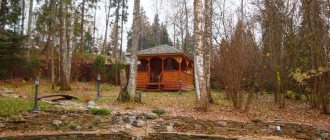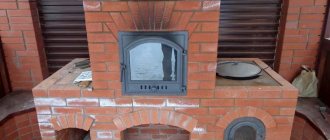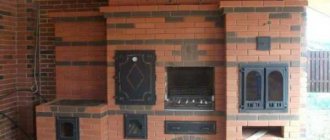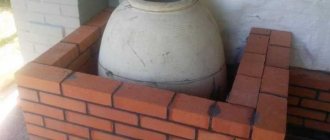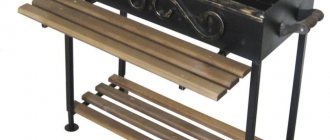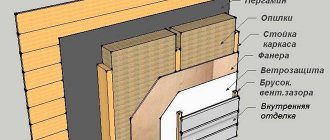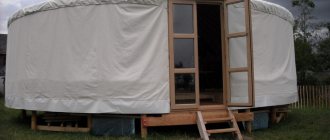A brick barbecue on the site of a private house or cottage is the central element of a recreation area. The stove can be placed in a gazebo or on the street, as an independent structure or as part of an entire complex - there are a lot of placement options and combinations of different functions.
Origin of barbecue
Many people are sure that barbecue originated in the USA, but this is not entirely true. Since ancient times, people have used a variety of devices for cooking meat over fire.
There are several versions about the origin of barbecue. An African tribe from the island of Haiti used an identical method of frying meat products, it was called “Barbacoas” and was first written about in 1553 in a book by the Spanish historian Cieza.
There is also a theory that the term barbecue comes from the French “barbe a gueue,” which means “from beard to tail.” The meaning of the expression is that the citizens of this country used to fry meat whole carcasses. In America, during the heyday of slavery, a dish of pig ribs, prepared in a similar way to barbecue, was popular among African-Americans.
Operating rules
Any thing requires proper and timely care. To avoid unpleasant consequences, you should follow the operating rules.
All structural parts should be cleaned in a timely manner, namely:
- the grate, doors and subsequent parts of the oven should be cleaned of dirt and soot each time after use, waiting until the oven has completely cooled;
- the stove pipe must be cleaned of soot at least 2 times a year;
- empty the area of burnt coal and food debris after each use;
- you need to check the firebox for accumulated water or snow if there is no cap in the chimney or a canopy over the chimney.
Experts recommend strictly following these safety rules:
- Constant monitoring of flame intensity is required;
- absence of flammable things near the stove.
When using ignition products, it is worth remembering that:
- Only starters are allowed to be used, strictly following their instructions for use;
- the use of gasoline, kerosene and other lubricants is strictly prohibited;
- cover the barbecue with a lid at least 15 minutes after ignition to prevent ignition of accumulated flammable gas;
- Under no circumstances should you soak firewood with such substances, only spray it for ignition.
In the cold season, the barbecue must be dried for 20 minutes over low heat before use. This will prevent premature wear and cracks in the furnace structure from sudden temperature changes.
35f473e3303adac961761186881157e5.jpe c0cc224e88508d542cb6134829a077f1.jpe
d6cbe40569440f1117db602691bffc1a.jpe
Varieties of barbecue
There are many different types of barbecues available these days. They are divided into portable and stationary, and can also differ significantly in terms of cost. When choosing a barbecue, they take into account not only the available amount of money, but the size of the free territory. It also takes into account the type of unit, which fuel (coal, gas, electricity) will be easier for you to use.
At the base of any barbecue there is a roasting pan with a grate where meat products are cooked. The simplest types of barbecue have only this detail. The more improved ones have many frying pans, ovens, shelves, lids, etc. List of main types:
- Disposable equipment is a small tray made of thin tin. It is filled with coals and covered with a simple grate. To cook, you just need to place the barbecue on a uniform surface. Cook it once and forget it, because all the coals burn out and the pan burns out.
- A portable barbecue is a design that quickly folds up and is transported in a special suitcase. This equipment is a standard fryer with a grate. This modification is perfect for a short trip to nature.
- The barbecue cauldron is extremely popular in the United States. Its highlight is the dome-shaped lid.
- The barbecue trolley is a complex design with a fixed or folding tabletop.
- Stationary barbecues are made of brick or stone. There is a work surface and a table for guests. Most often, such equipment has a roof or is created in the form of a gazebo.
- The gas design is ideal for cafes. It combines the functionality of a grill and barbecue. Sometimes such models are built into garden structures.
- Electric barbecues are intended for home use. They are compact and can be mounted on a regular table.
Recommendations from experts
The following tips will help improve the quality of the design and the aesthetics of its appearance:
- round the sides of the stove - this will make it look more attractive;
- lay the ash pit made of bricks, with the edges cut at an angle (45°) - the ash will crumble freely during operation;
- to shrink the bricks, use a rubber hammer - this is effective and does not damage the material;
- install doors so that you can open them with your left hand (for left-handed people with your right hand);
- When installing stove fittings, use a level;
- For a firebox made of fireclay bricks, lay them on edge - the space will be used efficiently and food will cook faster;
- Fireclay bricks and ceramics should not come into contact - be sure to lay basalt cardboard between them.
To set up a barbecue with a brick stove, you will have to spend a lot of time and effort, but the result will pay for it all many times over. A well-organized design will last a long time, and it can be used to prepare a variety of dishes.
Preparing for self-construction
If you have your own cottage with a small plot of land, it’s time to think about a barbecue for your summer cottage. Creating a barbecue is not the easiest thing, but if you decide to make it yourself, it’s worth going over the main points.
Selecting a location
Choosing a location is an important procedure; first of all, you need to think about fire safety. It is easier to select a corner in the garden and replant plants from there than to put out a fire carried by the wind to trees and houses.
It’s also worth talking to your neighbors about the barbecue in advance if you are planning to install equipment next to it. And of course, a convenient path to the picnic area would be a good solution. Additional requirements for the installation location:
- You must have full access to the site with equipment and a water source.
- It is necessary to place the barbecue near the cottage or house to make it more convenient to perform various actions. Bring water or take the keys.
- A safe distance must be maintained, keeping away from trees and the neighboring area.
- You should not place the structure next to a garage, greenhouse, bathhouse or other buildings.
- When choosing a free place near trees, you need to take into account the height of the pipe and the direction of the wind so that sparks do not harm them.
- There should be no children's attractions, fuel containers, reed fences, or hay near the equipment.
Important! You cannot use kerosene, gasoline or alcohol when cooking on a stove, and it is forbidden to soak it in lighter fluid in advance; it is only used to water the firewood before cooking.
Furnace type and size, drawing selection
Main types of homemade barbecues:
- A standard brick stove is considered the best option for a craftsman, but not a construction pro. It is not difficult to assemble such a structure; in the end, the stove itself should be in the shape of the letter P.
- Equipment with a roof and chimney is much more difficult to make, but kebabs cooked in it will please everyone. Among the important advantages of this model is the ability to cook even in rainy weather.
- Brick barbecue complex. Most often, it is bought already assembled in a special store and placed in a free place. Such a stove and its installation have many advantages: it does not require pouring the foundation and performing facing manipulations. Installation does not take much time.
- Brick grill and gazebo. Owners of large plots often want to make a recreation area and a gazebo in the backyard, because it is very convenient.
- Combination of barbecue and grill. This will help you cook a huge number of dishes at once.
- Separate oven smokehouse. This design has 3 floors, the last of which is considered a smokehouse.
Orders
A barbecue oven, especially an oven complex, requires proper ordering. The “fault” is the presence of a chimney and the need to adjust the draft. In this design, it is practically no different from a fireplace or a Russian stove, and calculating the order from scratch is not so easy. But you don’t have to do this yourself - there are quite a lot of designs for stoves of any size and functionality on the Internet:
- Small oven:
- Barbecue with woodpiles:
- BBQ oven with cauldron:
Barbecue drawings and diagrams
An individual drawing for a brick barbecue can be made using a ready-made version as a basis. In this case, it is necessary to consider the dimensions and elements of the structure. Also, it is important to calculate the height of the chimneys, the number of additional. fireboxes and other elements, think over their design features.
In addition to the fireboxes, it is worth equipping a place for coal or firewood, protecting the stove from precipitation, considering the design of a smoke elimination system and options for grates and spits. The project of a brick barbecue with a stove can be completed independently, using samples from the network as a basis. If you don’t want to bother too much, try making a structure from a barrel or cylinder.
We are looking at the location
To avoid fires, you should not place a barbecue with a smokehouse near trees, bush plantings and wooden buildings.
Children’s play areas should also be away from the braziers, and the summer kitchen and woodshed, on the contrary, should be closer so as not to have to go far for supplies.
Required tools and materials
To build a barbecue with your own hands, you need to prepare:
- Fireproof type brick.
- Two or three bags of concrete powder.
- Remains of iron and wire.
- Several boards.
- Ruberoid.
- Metal tubes.
- Ordinary brick materials.
- Rubber hose.
- Stainless steel sink and faucet.
The amount of material depends on the stove design itself: the type of masonry and size. To build a barbecue with your own hands, prepare the following equipment:
- Building level.
- A big shovel.
- Thick thread.
- Wedges.
- Basin or bucket.
- Master OK.
Pouring the foundation, laying the furnace with your own hands
To form a good foundation, you will have to follow step-by-step instructions:
- First you will need to choose a suitable location where the furnace will be built.
- Using pegs and regular twine, mark the selected area.
- Take a shovel and dig a hole 25 centimeters deep.
- Place the formwork.
- Prepare the mixture using a sand to cement ratio of 3 to 1.
- Pour the solution into the hole.
Remember that the base must be reinforced. To do this use:
- reinforcing mesh;
- reinforcing bars.
If you prefer the mesh, it will need to be laid 2 times. Moreover, the primary layer is placed when the third part of the pit has already been filled with the mixture. Then the base will need to be filled again by ⅓, making another layer, after which the hole will be completely filled with the mixture. The rods are laid in the center of the base of the pit, then they will need to be filled with mortar. After pouring, the foundation must be given time to completely settle.
Components of the work
Then everything is done as usual. A pit is dug (40 cm), a pillow is laid (fifteen centimeters). Everything is covered with gravel or crushed stone. In general, the entire part that is poured should occupy about 25 centimeters.
The formwork is being installed. It must be carefully aligned and protrude ten to fifteen centimeters. The next stage is the installation of fittings. It should be in the form of a ten by ten centimeter grid. A solution is prepared (cement and sand in a ratio of 1:3), which is used to fill the formwork.
How to choose a phytolamp for indoor flowers- Flowers are the best gift
Advantages of corner kitchens with a sink and what to consider when choosing them
Let's move on to the masonry
To quickly make a brick barbecue, you need to do a little fitting. Of course, arranging a brick structure is not a process that needs to be done in an accelerated manner, and therefore fitting will be required, which is carried out according to a sequential scheme:
- The bricks are laid dry on the foundation part.
- The results of the fitting are studied and recorded.
- Such manipulations help in the work process, to operate whole blocks and brick halves.
- If you already have a grate or tray, their parameters must be taken into account when laying.
- After laying out the material, you need to outline the masonry line so that you can then work on it.
Before laying, the bricks are prepared. Not everyone knows that they can absorb water, which leads to weakening of strength. Therefore, a day before starting work, it is worth leaving them in containers with water overnight. You need to start creating a barbecue when the brick materials are dried on the outside, but contain moisture inside.
It's time to start building a barbecue grill for your dacha with your own hands. Prepare the material and solution, then start laying out the first row. Make sure that the space between the materials is completely filled with the mixture and that the brick products sit correctly. To press them into the mixture, use a rubber mallet.
Thinking over the type of oven
It depends on the type of barbecue: whether a canopy is needed, the type of heating and smoke exhaust system. You can immediately think about expanding the possibilities of a barbecue by installing an oven, smokehouse, grill, cauldron.
When you have your dream stove in your head, it would be nice to transfer it to paper by creating a drawing of a barbecue and calculating the necessary building materials.
Construction of the basement
After building the first row, you will have something to focus on. Remember that the masonry must be done in a checkerboard arrangement. This means that all rows must be shifted half a brick to the side. When performing work, you will have to periodically check the plane of the structure. To do this, work with a level and plumb line. The masonry on corner joints is reinforced with metal wire.
To ensure good reliability of the main part of the barbecue oven with your own hands, you need to prepare suitable fastenings. For example, good fit:
- metal corners;
- reinforcement rods.
Also, don’t forget about the side gaps of the barbecue bricks that will not be filled with the mixture. They are used in the form of a trench.
Laying the foundation
You can lay a finished road slab as a base, but this option has more disadvantages than advantages. And usually the foundation is poured with your own hands. The area of the slab is made according to the size of the furnace, with small tolerances around the perimeter. And the area in front of the barbecue is then laid out with the same tiles as the paths on the site.
Even at the design stage, the excavation depth and the thickness of the slab are calculated so that the surface of the slab rises 50-60 mm above the ground.
If the barbecue oven is relatively small, then it is enough if the thickness of the slab is within 10 cm. For a large oven complex, it is better to calculate the parameters of the slab based on the properties of the soil and the total load on the base. In this case, it may be necessary to fill a slab with a thickness of 12-15 cm.
Preparation
A step-by-step algorithm for preparing a site for concreting looks like this:
- Mark the place with pegs and string.
- Remove the top layer of soil to a depth of about 30 cm.
- Level and compact the bottom.
- Install formwork from edged boards or OSB strips. For reliability, tie the corners with “kerchiefs” made from scraps of material.
- Fill with crushed stone and sand in a total layer about 15-20 cm thick. Level, water and compact with a tamper.
- Cover the separating layer with rolled waterproofing. It will protect the foundation from getting wet by groundwater, and will not allow moisture to escape into the sand from the concrete during its maturation. The strips are laid overlapping by 15-20 cm, with access to the end of the future slab.
- A mesh of reinforcement is placed on the supports. You can link it yourself, but it’s easier to use a road grid map with parameters 100x100x6.0 mm or 150x150x8.0 mm. The reinforcement should lie approximately in the middle of the slab at a distance of at least 30 mm from the bottom and top surfaces. Along the perimeter, the mesh should not reach the boundaries of the formwork by 30-50 mm.

